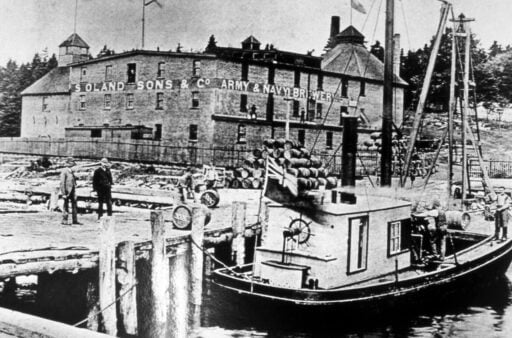From The Story of Dartmouth, by John P. Martin:
In the winter of 1867, Halifax newspapers carried unusually long accounts of seasonal activities on our lakes, such as games of curling, hockey and ice-boating. Up to about the mid-century there was only occasional reference to such recreations, perhaps because of the few persons participating. Now with a skate factory located in our midst, hundreds of others must have joined in the fashion. Increasing crowds came over from Halifax especially on holidays and Sundays. The bright uniforms of naval and military officers gliding over the glassy surfaces with their lady partners amid the throngs on our various lakes, created quite a colorful scene.
The “Halifax Reporter” of that time observed that it was curious the way that skating enthusiasts of Halifax changed their locations in different seasons. One year Maynard’s Lake in Dartmouth has the best ice; the next year the North West Arm will be the ‘favorite; and another year First and Second Dartmouth Lake will bear the palm, said a writer of that day.
The following account from the same newspaper of Feb. 17th. 1867, clearly proves that hockey was a long-established sport hereabouts:
On Saturday there were about 1,500 people at Oathill Lake. Two well contested games of ricket were being played at the upper end of the lake where a number of young men from Dartmouth and the City were playing their hurleys and “following up” the ball. The centre of the lake was occupied by a number of officers of the Garrison and the Fleet in a match game called hockey, i.e., ricket.
Very little science was displayed in either game, the old class of players seems to have died out, and their successors are not up to the science of leading off the ball, doubling and carrying it through. Instead of the old style, the game as now played is dangerous to outsiders especially the ladies, some of whom were rather roughly treated in the scrimmages after the ball.
On July 1st, 1867, the Dominion of Canada came into existence. One of the last shots fired by the opposing forces was the brilliant speech of Joseph Howe delivered in McDonald’s Hall at Dartmouth. A verbatim report may be found in Volume II of Howe’s Letters and Speeches edited by Sir Joseph Chisholm.
Nova Scotians expressed their anti-Union feelings in the first Dominion elections that September, by sending to Ottawa 18 Liberals and One Conservative. (The latter was Dr. Charles Tupper.) Polling booths in Dartmouth were at Huxtable’s shop near the Engine House, and at Alex. Hubley’s at Black Point, (probably Black Rock). Dartmouth Township gave a majority for the anti-Unionists, while Chezzetcook and Preston voted for the Unionist candidate. Joseph Howe ran for Hants, and was elected. On his return to the City, he was met at the ferry in Dartmouth and escorted in a torchlight procession to “Fairfield”, while bonfires blazed on the hills, and an 18-gun salute was fired.*
One of the worst conflagrations in Dartmouth occurred in mid-November on a rainy and windy Sunday, about two o’clock in the morning. Seven buildings fronting on Portland Street and on King Street at the southwest corner, were completely gutted. The magnificent but terrible illumination could be seen from Halifax and the surrounding country. A fire engine came over from the City.
At the Paris Exhibition in 1867, a model of a quartz-crusher from Symonds Foundry at Dartmouth, received honorable mention. S. Oland and Son bought the Albro Tannery land at Turtle Grove, and commenced their well-known brewery business. The Dartmouth Axe and Ladder Company was organized, with Henry Watt as Captain. St. James’ congregation purchased from Dominick Farrell for $1,600, land at the southeast corner of King and Quarrell Streets as a site for their new church. An 11-year-old boy named Bishop was killed while riding on a car of the inclined plane at the Canal. Contractor Jonathan Elliot died that year aged 70; also Peter Laidlaw 48, and James P. Dunn 42, (the last body in Dunn’s vault).


